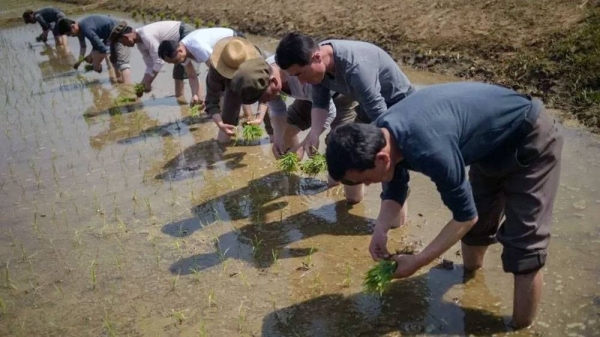PYONGYANG — North Korea is experiencing a critical food crisis, experts say. The country is no stranger to chronic food shortages, but border controls, poor weather and sanctions have worsened the situation in recent years. Top officials are expected to meet at the end of February to discuss a “fundamental change” to agriculture policy, state media has said.
This is a “very important and urgent task” amid “pressing” farming issues, news aggregator KCNA The news comes as Pyongyang continues its displays of military might. One state newspaper has likened using foreign aid to “poisoned candy”. On Wednesday, Rondong Sinmun wrote that “imperialists” used aid as a “trap to plunder and subjugate” recipient countries.
South Korea’s Unification Ministry has reportedly also sounded the alarm on the food shortages and asked the World Food Program (WFP) for help. Satellite imagery from South Korean authorities shows that the North produced 180,000 tons less food in 2022 than in 2021. In June, the WFP raised concerns that extreme weather conditions like drought and flooding could reduce production of both winter and spring crops.
State media also reported late last year that the country was experiencing its “second worst” drought on record. As forecasted, food prices have risen this year amid poor harvests and people have been turning to inexpensive alternatives, said Benjamin Katzeff Silberstein, who works with North Korea-centered publication 38North. org.
The price of corn has risen 20% at the start of 2023, with growing demand for the less preferred — compared to rice — but more affordable staple, reported Rimjin-gang, a North Korean magazine based in Japan. “If people are buying more corn it means food overall is getting more expensive, and staple foods like rice in particular,” Silberstein said. A kilogram of the crop now costs about 3,400 North Korean won (£3.
10; $3. 80). North Korea is ranked one of the poorest countries in the world.
Recent estimates are scarce, but CIA World Factbook estimates its gross domestic product per capita to be around $1,700 in 2015. That said, the actual situation and numbers are unclear, given North Korea’s opaque economy. “Due to North Korea’s strict COVID border measures on goods and people, there’s no way for any outsiders to go into the country and check for themselves what the situation is,” said James Fretwell, an analyst at NK News.
These measures have also made it difficult for organizations outside North Korea to send help in times of crisis, he added. North Korea has also strictly restricted cross-border trade and traffic since January 2020. Sokeel Park, South Korea country director in non-profit Liberty in North Korea (Link), described the regime’s response to the pandemic as “extreme and paranoid”.
Park, whose organization helps resettle North Korean refugees in South Korea or the US, said the supply of basic necessities in the North has been dwindling since the start of the pandemic. Link has heard multiple credible reports of people starving to death, Park said. The country has also seen a significant decline in humanitarian aid from the international community — the UN Office for the Coordination of Humanitarian Affairs said North Korea received $2.
3m (£1. 9m) from international organizations and other agencies last year, down from $14m in 2021. While this may be a result of prolonged border closures, some relief workers told the BBC that international sanctions, which have tightened in response to North Korea’s military provocations, have also hindered the delivery of humanitarian supplies.
Still, there are some signs that cross-border economic activity is starting again. Nikkei Asia reported last week that some truck travel with China, which accounts for over 90% of North Korea’s trade, has resumed. But that does not necessarily mean standards of living will improve for ordinary North Koreans.
Much of North Korea’s spending goes on the military — its latest missile launchers were displayed earlier in February Much of North Korea’s spending goes on the military — its latest missile launchers were displayed earlier in February Park said the regime has focused its resources on its missile prowess and propaganda, at high social costs. Pyongyang fired a record number of ballistic missiles last year — more than 70, including intercontinental ballistic missiles, or ICBMs, which can potentially reach the US mainland. Early this month, it showed off its largest-ever display of ICBMs at a military parade.
“The regime has acknowledged how hard things are for ordinary North Korean people, but continues to prioritize propaganda and pageantry for the Kim family, missile launches, and strict controls [on] the population,” Park added. Experts worry that the situation on the ground will deteriorate further, leading to a famine as devastating as the one the country experienced in the mid-to-late 1990s, often known in official documents as the “Arduous March”. Estimates put the number of deaths between 600,000 to a million.
“We don’t seem to be near the levels of the 1990s famine,” Silberstein said. “But margins are razor thin. So even a slightly lessened supply of food could potentially have dire consequences.
” — BBC < Previous Page Next Page >.

